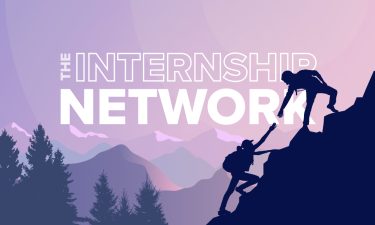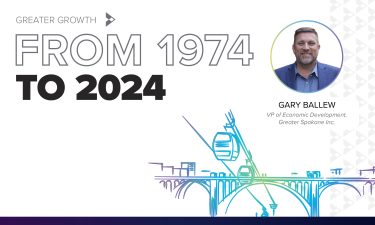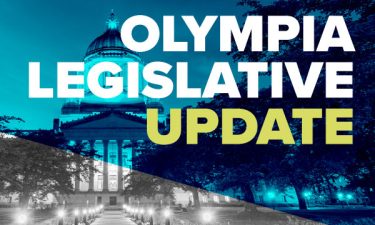Fund benefits program at Rogers High School
written by Rachel Quick, Milagros Yoch, and Erin Sellers with the Innovia Foundation
Amid the COVID-19 pandemic, STEM education has never been a more relevant investment for schools and communities, according to a retired instructor at Rogers High School, in Spokane.
The teacher, who wishes to remain anonymous, is challenging the Spokane community to match her $110,000 donation to the Rogers STEM Spirit Fund, at Innovia Foundation. Through the challenge, every dollar donated by the community to the fund will be matched up to $110,000. The funds will be used for STEM education at Rogers High School and provide support for continuing education of Rogers graduates advancing careers in STEM, which is short for science, technology, engineering, and math.
“This experience helps students have vision for their future,” says Carol Kaplan, a current biomedical teacher at Rogers, who has watched STEM education transform at the school over the past 18 years. “When they get that dream and see how they could achieve it, they are more likely to work hard toward that career. It may take them some time, but they persevere to accomplish the goals.”
The four-year program at Rogers exposes students to STEM professionals’ activities. Students choose a biomedical, engineering, or computer science track and take classes that ask them to think like the professionals in that field, such as tackling aerospace engineering projects or tracing the source of a mock outbreak.
Students from all three tracks are given the opportunity to participate in an independent research class that culminates in a presentation at the Eastern Washington Regional Science and Engineering Fair. Students are challenged to identify a problem and design their own way of investigating it using the tools honed during their first three years.
The Rogers STEM Spirit Fund enables the school to invest in resources like centrifuges, genetic testing kits, computers, and engineering equipment that immerse students in a broad spectrum of STEM careers and allow them to dive into the areas that interest them most, Kaplan says.
“These students would all say that having the opportunity to experience and use actual equipment for the biomedical field in their labs has helped them decide on a career path that is meaningful to each of them,” she says.
For Samuel Milsap, a 2019 Rogers graduate, the STEM program inspired an interest in engineering. Now a sophomore at the University of Washington, Milsap credits the experiences he gleaned in engineering classes during his senior year at Rogers with igniting his passion to pursue an aerospace degree.
“I learned two of the most essential skills of an engineer from the STEM program: problem solving and teamwork,” Milsap says.
Britny Farrar, a 2018 Rogers graduate and one of Kaplan’s biomedical students, used the skills she developed at Rogers to land a job as an environmental monitoring technician at Jubilant HollisterStier LLC, a Spokane-based pharmaceutical company that makes sterile injectables and diagnostics products and a line of immunotherapy allergy injections. At Rogers, Farrar learned how to don personal protective equipment, operate autoclave sterilization equipment, and practice aseptic techniques, all of which are skills that she uses daily in her work to maintain a sterile, safe environment at Jubilant HollisterStier.
The Rogers program simulates practical STEM experiences for students and facilitates connections with companies. Jubilant HollisterStier has partnered with Rogers to pair lab employees with students, who collaborate on projects as a part of their coursework.
James King, a senior quality control manager at Jubilant HollisterStier and graduate of Rogers, says training Rogers students in STEM skills not only prepares them for high-level careers, but also gives the company the opportunity to invest in its community.
“JHS is located in Hillyard, right next to Rypien Field, and many of our employees live in this area,” King says. “It is important to JHS as a company to not just do business in this area, but to give back in any way we can and invest in our future.”
The typical Rogers student faces challenges in pursuing post-secondary education, data show. Rogers has the highest mobility rate among Spokane’s five comprehensive high schools, with 28.8% of students expected to move during the next school year, says Lori Wyborney, the school’s principal.
Of Rogers graduates who go on to a two-year or four-year college, only 70% can continue for a second year. For those able to persist past their freshman year, only 27% obtain a degree within eight years, compared with 46% of high school graduates across Spokane, Washington state Education and Research Data Center statistics show.
Shawn Carney, a physics and engineering department teacher and science department lead with 22 years of experience at Rogers, has witnessed the impact of the Rogers STEM Spirit Fund in helping students overcome barriers through scholarship opportunities.
“These are hardworking students who have been through one of our STEM pathways and are looking at continuing their education in a STEM field,” says Carney. “We look forward to expanding these scholarships to support more students in getting over the financial hurdle that many of them face, so they can focus on changing their lives and changing the world through STEM.”
Although Rogers students face obstacles, recent data suggests that investment in STEM education can pay off significantly for students and their communities. Within the next five years, 740,000 STEM jobs are expected to open across Washington, according to a Washington Roundtable report.
Nationwide, nearly 30% of the fastest-growing occupations in the next decade will require some background, according to the Spokane STEM Network.
Cassidy Peterson, Spokane STEM Network executive director, says she believes the Rogers program provides students with the kind of exposure and tangible experiences they need to succeed in a world increasingly driven by STEM education.
It’s critical for the Spokane community to continue identifying resource barriers that can be eliminated, Peterson asserts.
“Over the next decade, we need to prepare young people to fill the vast amount of job openings in our regional economy that will demand STEM knowledge and skills,” she says. “Through identifying needs and working together as a network, we can introduce students to STEM careers at a younger age. That can be a key part of the solution to end generational poverty.”
As Rogers teachers look to the future, they see investment in the Rogers STEM Spirit Fund as playing a significant role in equipping students with tools and experiences that reflect evolving STEM jobs and technologies.
Kaplan says, “It takes equipment and money for students to run labs that have significance and a connection to the biomedical world.”
Kaplan says she believes that more experimental opportunities will open for biomedical students with investment in the school’s existing lab equipment, including a new spectrophotometer and a small fume hood.
Carney’s hopes are focused on a new piece of equipment for the engineering classes: a continuous-fiber 3D printer which would give students the freedom to design, print, and use parts composed of structurally stable materials, such as fiberglass.
If every dollar in the $110,000 challenge pledge is matched by community members, educators’ dreams for the program may become reality, giving students access to equipment and opportunities essential for their future careers and the chance they deserve for their dream to thrive.
Contributions can be made to the matching challenge by visiting innovia.org, clicking on the Give Now button and selecting Rogers STEM Spirit Fund.




